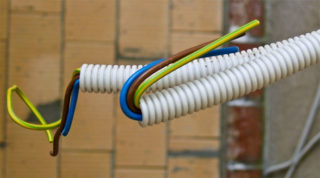In a modern home, a large number of household appliances of various capacities are used that run on electricity. For this reason, household wiring has many branches. All individual sections must be correctly and securely fixed in order for the power grid to work efficiently. When installing conducting cables and wires, they use the rules and recommendations established by the PUE.
Basic rules for laying wires and cables
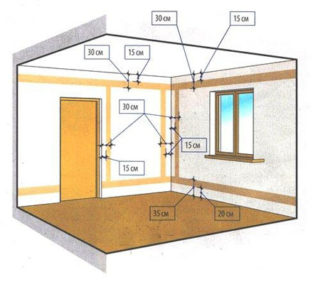
The safety and reliability of the entire electrical network in an apartment directly depends on the rules for wiring. To create a high-quality electrical network, you must comply with the following requirements:
- For the premises, especially in a new building, a project for the supply of electricity is necessarily created. The plan shows the wiring diagram, the necessary materials, the installation location of the shield, junction boxes, sockets, switches.
- Calculation of the cross-section of conductors, the choice of cable material. Better to choose a copper conductor. The best budget option is VVG brand products.
- The use of automatic devices to cut off the power supply in case of an emergency. Each group of devices has its own circuit breaker. For powerful electrical installations - for 25 A, for sockets - 20 A, for lighting, a rating of 16 A is enough.
- A number of household appliances require separate wiring. These are electric stoves, powerful consumers of electricity, lighting, sockets.
- The main shield must be installed at the entrance of the main cable to the room. Access to it should not be difficult for inspection and possible repair.
- It is recommended to comply with the SNiP norms for the placement of sockets and switches.
- Wires are laid vertically or horizontally in closed ducts. There should be no intersections.
- Conductors should fit snugly into the groove for ease of subsequent repair. Single wires should be fixed along their entire length at a distance of 90 cm. Cable bundles should be fixed every 50 cm. Horizontal lines should be installed at a distance of 15-20 cm from the floor and ceiling and 10 cm from corners and openings.
- Hidden lines must be laid in corrugations or pipes.
- The order of installation of the rules for connecting conductors must be observed. Particular attention should be paid to the contact of dissimilar wires (copper and aluminum).
During installation, it is imperative to de-energize the room. All work is carried out in compliance with safety regulations.
Preparatory work
All materials should be prepared in advance. It is necessary to measure and cut the required number of cords, cables, pipes, sockets, junction boxes, fasteners. A suitable tool is selected - a perforator acts as the main one. You will need threaded crowns for drilling, a screwdriver, an assembly tool.
When everything is prepared, the method of laying is selected and the installation of electrical wiring begins. How to properly secure the cable depends on the installation method.
Criteria for choosing a laying method
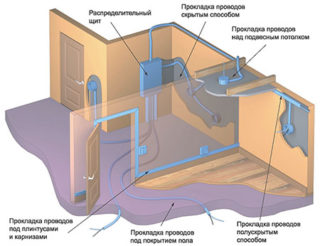
How to lay electrical wiring in the house is determined by various factors:
- environmental conditions;
- location;
- electrical circuit, dimensions and cross-sections of wires.
Environmental conditions include temperature and humidity. These indicators can affect the integrity of the product. If the insulation is damaged due to improper selection of the conductor for the climatic conditions, the risk of electric shock or fire to a person increases. Each cable has its own operating conditions, which must be met. Hands should be wearing rubber gloves, and all tools should have insulated grips.
The installation method, safety and ease of use depend on the choice of the installation site. An important point is the ability to check the wiring for performance.
Fixing cables for different types of wiring
The way of wiring is influenced by the type of wiring, apartment category, building material. There are two ways of laying - open and hidden. Each of the methods has its positive and negative features, and each uses its own fasteners for the wires to the wall.
Open wiring
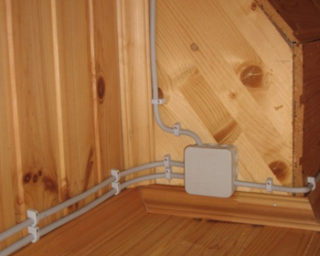
An open wiring is usually chosen if it is impossible to make a hidden one. Wires are laid in special cable channels and boxes. The wires are fastened with clips on the walls and ceiling. The disadvantages include the visual component - the wires are visible and may not fit into the interior, which will violate the aesthetics of the room. The main advantages are ease of installation, high speed of implementation, access to wires.
Most often, open wiring is used in the following cases:
- Creation of an electrical network in auxiliary rooms. These include garages, attics, basements.
- Lack of cable channels in the room.
- Designing a living space in a retro style or otherwise, which fits into an open wiring.
Regardless of the area of use, the wires can be fixed in different ways.
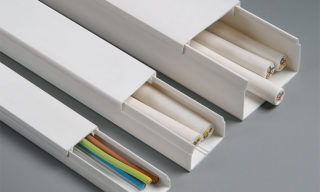
Decorative boxes, as they are also called cable channels, are created from a fireproof polymer. They are widely used in offices, wooden houses and summer cottages.
Products are long boxes with a lid, which is attached to the base with side latches. They have different sections - triangular, rectangular. There are also segment-type channels designed for installation on an unprotected floor mount.
There can be partitions inside the channel, allowing to form separate sections for bundles.
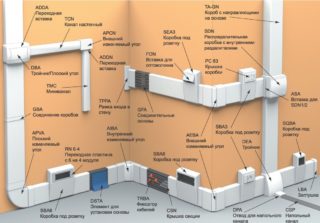
The wiring requires the use of various additional elements to attach the duct:
- corners;
- end caps;
- transitional parts;
- butt pads;
- bases for mounting switches, sockets, sensors.
The cable duct has good aesthetic properties, is easy to install and securely fixed. It protects conductors from external influences, including mechanical ones, throughout the entire service life. The main fixture is a screw that is screwed into a pre-installed plastic box. The wire is fastened to the wall at a distance of 50 cm.
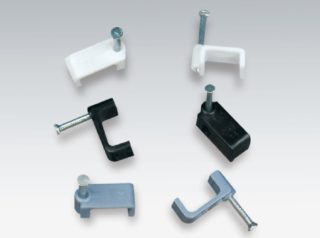
One of the most common types of holders are plastic and metal staples... They are a small piece that has a recess for a round cable and a hole for fastening. On plastic products, the retainer is already installed in the case. They come in different sizes.
Metal fixtures can be clamped and clamped. The latter can be one- and two-footed.
The functional analogue of staples is dowel clamp... The difference lies in the mounting method. To mount the clamp, a hole is first made, then it is put on the cable and inserted into the hole made. In the case of mounting the wall plug, it also functions as a plastic air suspension.
Plastic clips are also considered popular fasteners. They hold the cable through the compressive action of the springs. The main fixing part is the screw, but glued mounting products are also available. Size suitable for single conductor installation. Can also be used for fixing tubes and channels. There are different diameters.
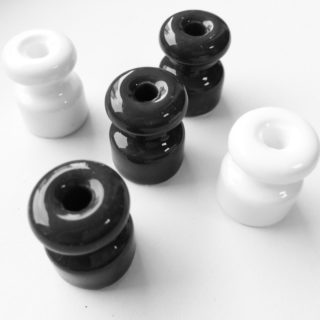
Insulators called small barrels with a circular groove, which is offset from the center, and a hole in the middle for the bolt. Due to the smooth edges of the housing, the insulation is additionally protected from damage. Outwardly, they look aesthetically pleasing. Previously, they were made exclusively of ceramics and were white, but now the color gamut has expanded due to the popularity of retro-style interior design.
The most common application is to secure a coiled cable. The recommended distance is 50 cm, but it can be increased up to 80. The selection depends on the degree of sagging of the conductor.
The universal fastening element is clamp-tie... It is often used in other fasteners. It is a plastic strap with a central lock. The belt has a grooved part that allows you to securely fix the end of the tie in the lock and prevent it from slipping out.
Such fasteners are often used when routing wires and pipes on cable trays. The main advantage is ease of use.
Hidden wiring
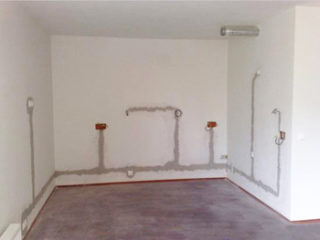
In the case of hidden installation, the cables are not visible to the eye. They are installed in the wall in special grooves. This type of gasket is actively used in the presence of suspended and stretch ceilings. Due to the installation in the wall, there is no aesthetic requirement for the clamps. Performed in all rooms of the apartment (kitchen, bedrooms, living room).
The plate with the mounting hole is the simplest fastener. It is a plastic part with one or two lugs on the front side. After installing the frame platform, the conductor can be fastened with ties.
On sale you can find platforms with an integrated plastic clamp. They are used less frequently. The platform itself can be attached with glue or a screw.
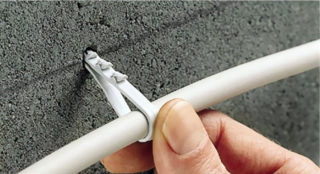
Dowel clamp is a combination of a dowel with a mounting plate. Such a device involves the use of a separate screed, but there are products with an integral component. To improve the fixing strength, instead of a notch, ribbing of the rod with round sections can be made. The fastening becomes reliable due to the fact that the dowel is driven into a hole with a diameter smaller than the diameter of the ribbing.
To fasten the conductors in the grooves are used quick-drying formulations... The most popular are gypsum and alabaster. To fix it, it is necessary to cover the sections on the cable with a mixture every 50 cm.
The advantages include low cost, high installation speed and no need to purchase additional parts. The main disadvantage is the low channel capacity, which allows you to hold no more than two wires. Not suitable for laying corrugated pipes in grooves.

Clamps similar in design to clips. The main difference is fastening with a rigid integral clamp. There is a group design of clamps that allows you to simultaneously fix several wires or plastic pipes.
Such devices are more expensive than classic clips due to the increased complexity of the design. They allow you to fix cables with different diameters, which is the main advantage. They can also function as a free support guide.
Less commonly, Velcro is used in installation due to its inefficiency.
Features of using point attachment elements
If external wiring is made from the post, it is better to use black plastic products. They are made of carbon black, which is a stabilizer and protects the conductor from the negative effects of ultraviolet rays.The plastic will retain its appearance and will not degrade.
A gross mistake is fixing a new cable to an already laid one. This is due to the fact that the fasteners are designed for a certain weight and load, and the additional conductor will increase these indicators and lead to a breakdown in the connection. Especially often, this error appears when adding wiring lines in a panel house.
If single-legged metal brackets are installed, care must be taken to ensure that the fixing elements are placed on one side.

